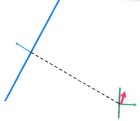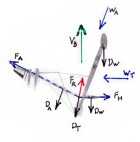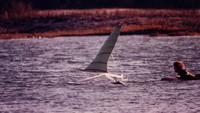High-Speed Sailing
| Vessel Name: | Sailien |
| Vessel Make/Model: | Experimental/custom |
28 September 2013
The America’s Cup
I watched, with interest, the videos of the 34th America’s Cup. At last we have fast sailboats engaged in a competition that is fun to watch. The virtual images (such as course boundaries, distance grid lines, separation between boats, etc.) overlaid on the real images really helps to keep the race [...]
31 August 2013
100 Knots for Hydroptere?
The latest news from Hydroptere is that they have plans for a 100 knot sailboat. This was posted on 26 Aug 2013, so look for that date at this address. http://hydroptere.com/en/the-news/last-news/
17 November 2012
Aptly named Sailrocket, blasts off!
While yet to be ratified, Sailrocket posted an average speed over 500 meters of 59 knots. I will not be surprised if they increase their record into the 60 knot range during this record attempt.
02 January 2012
More drag for VSR2?
I want to start by pointing out that the whole VSR2 team has done a stellar job and has demonstrated conclusively that the forces that drive a sailboat can be aligned for roll stability without using ballast and without using any down-force. (Trifoiler achieved roll stability by using down-force, but [...]
18 December 2011
My analysis of Sailrocket
I copied a diagram of VSR2 (wing doesn’t show well) and added in the major force arrows that apply. Be aware that these arrows are not correct in terms of scale (length) and some of their locations are guesses, however I believe I’m correct enough for us to learn something about what VSR2 has been [...]
23 October 2011
60 is within reach, what’s next?
I have been watching Sailrocket’s progress with great interest and there’s no question they have a winner. I fully expect to see them reach 60kt in the near future. Sailrocket has now demonstrated what I first learned with my models and again with my full-sized prototypes, that if you get the forces [...]
Notes on Wotrocket
Near the end of the video as the craft gets powered up, it looks like the lead hydrofoil lifts the nose of the craft and then the craft appears to rotate off the wind a bit, lose lift, causing the nose to crash back to the surface, submerge and pitch-pole the boat. The fact that the boat rotated off the wind leads me to suspect that the vertical strut of the nose foil was lifted far enough out of the water that its "side bite" diminished, causing it to drift sideways. The boat is being "squeezed" between the water pressure on the vertical hydrofoil struts - one fore, one aft and the air pressure on the wing. If side bite is lost on either strut, the craft will rotate (yaw). It also looks like they had pretty much lost roll control as the crew pod was too high as well.
I've had experience with something similar, in which I'd placed a hydrofoil under each of two pods. The hydrofoils worked great and lifted the pods out of the water but then went across a wave trough, hit the next wave enturbulating the water flow, lost lift and crashed the pod back to the surface. I had no control problems, but the boat would slow every time it hit the next wave (wind swell/chop).
Hydrofoils do pose a problem for pitch control because they have to maintain a constant distance from the surface and there is very little margin for error. Trifoiler (which see) has a great solution, but there are other ways to do it. No matter how done, pitch control will have to be automatic. I do not know how Hydroptere controls pitch but would like to find out.
Bob
About & Links
- Bob's Surfing Blog
- Bob's Website
- Greenbird (Windjet)
- l'Hydroptere
- Le Projet Dared
- Macquarie Speed Sailing Team
- Monofoil Sailing
- Mountain Goat STOL
- Mr Smith's Amazing Sailboats
- Patent Office (Search)
- Radboat
- Sailien Prototypes (early), Delta, etc.
- Sailien Video
- Sailien Website
- The Basics of Surfboard Design
- The Basics of Surfboard Design en Espanol
- The Swedish Speed-Sailing Challenge
- Trifoiler
- Vestas Sailrocket
- Windjet Project
- WSSRC


